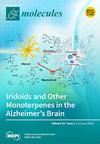An Integrated Strategy of UHPLC-ESI-MS/MS Combined with Bioactivity-Based Molecular Networking for Identification of Antitumoral Withanolides from Athenaea fasciculata (Vell.) I.M.C. Rodrigues & Stehmann
IF 4.2
2区 化学
Q2 BIOCHEMISTRY & MOLECULAR BIOLOGY
引用次数: 0
Abstract
Background: Athenaea fasciculata, a Brazilian native species from the Solanaceae family, is recognized as a promising source of bioactive withanolides, particularly Aurelianolide A and B, which exhibit significant antitumoral activities. Despite its potential, research on the chemical constituents of this species remains limited. This study aimed to dereplicate extracts and partitions of A. fasciculata to streamline the discovery of bioactive withanolides. Methods: Using ultra-high-performance liquid chromatography–tandem mass spectrometry (UHPLC-MS/MS), various extracts—including n-hexane, methanol, and ethanol—were analyzed, and their mass spectrometry data were processed through the GNPS platform for the generation of molecular networking. The results indicated that crude extracts displayed comparable cytotoxicity against Jurkat cells, by treatment at 150 µg/mL, while alcoholic extracts achieved approximately 80% inhibition of K562 cells and K562-Lucena 1 at the same concentration. Notably, the dichloromethane partition exhibited the highest cytotoxicity across leukemia cell lines, particularly against Jurkat cells (IC50 = 14.34 µg/mL). A total of 22 compounds were annotated by manual inspection and different libraries, with six of them demonstrating significant cytotoxic effects. Conclusions: This research underscores the therapeutic potential of A. fasciculata and highlights the effectiveness of integrating advanced analytical methods in drug discovery, paving the way for further exploration of its bioactive compounds.超高效液相色谱-电喷雾电离质谱/质谱结合基于生物活性的分子网络鉴定 Athenaea fasciculata (Vell.) I.M.C. Rodrigues & Stehmann 中的抗肿瘤 Withanolides 的综合策略
背景:Athenaea fasciculata 是茄科植物巴西的一种原生物种,被认为是一种具有生物活性的山奈酚苷类化合物,尤其是 Aurelianolide A 和 B,具有显著的抗肿瘤活性。尽管该物种潜力巨大,但对其化学成分的研究仍然有限。本研究旨在对 A. fasciculata 的提取物和分馏物进行脱模复制,以简化生物活性羊角烷内酯的发现过程。研究方法采用超高效液相色谱-串联质谱法(UHPLC-MS/MS)对正己烷、甲醇和乙醇等多种提取物进行分析,并通过 GNPS 平台处理其质谱数据,生成分子网络。结果表明,粗萃取物对 Jurkat 细胞的细胞毒性相当,处理浓度为 150 µg/mL,而酒精萃取物在相同浓度下对 K562 细胞和 K562-Lucena 1 的抑制率约为 80%。值得注意的是,二氯甲烷提取物对各种白血病细胞株的细胞毒性最高,尤其是对 Jurkat 细胞(IC50 = 14.34 µg/mL)。通过人工检测和不同的文库共注释了 22 种化合物,其中 6 种具有显著的细胞毒性作用。研究结论这项研究强调了A. fasciculata的治疗潜力,并突出了在药物发现中整合先进分析方法的有效性,为进一步探索其生物活性化合物铺平了道路。
本文章由计算机程序翻译,如有差异,请以英文原文为准。
求助全文
约1分钟内获得全文
求助全文
来源期刊

Molecules
化学-有机化学
CiteScore
7.40
自引率
8.70%
发文量
7524
审稿时长
1.4 months
期刊介绍:
Molecules (ISSN 1420-3049, CODEN: MOLEFW) is an open access journal of synthetic organic chemistry and natural product chemistry. All articles are peer-reviewed and published continously upon acceptance. Molecules is published by MDPI, Basel, Switzerland. Our aim is to encourage chemists to publish as much as possible their experimental detail, particularly synthetic procedures and characterization information. There is no restriction on the length of the experimental section. In addition, availability of compound samples is published and considered as important information. Authors are encouraged to register or deposit their chemical samples through the non-profit international organization Molecular Diversity Preservation International (MDPI). Molecules has been launched in 1996 to preserve and exploit molecular diversity of both, chemical information and chemical substances.
 求助内容:
求助内容: 应助结果提醒方式:
应助结果提醒方式:


